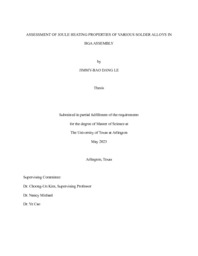
ATTENTION: The works hosted here are being migrated to a new repository that will consolidate resources, improve discoverability, and better show UTA's research impact on the global community. We will update authors as the migration progresses. Please see MavMatrix for more information.
Show simple item record
| dc.contributor.advisor | Kim, Choong-Un | |
| dc.creator | Le, Jimmy-Bao D | |
| dc.date.accessioned | 2023-06-14T17:06:41Z | |
| dc.date.available | 2023-06-14T17:06:41Z | |
| dc.date.created | 2023-05 | |
| dc.date.issued | 2023-05-22 | |
| dc.date.submitted | May 2023 | |
| dc.identifier.uri | http://hdl.handle.net/10106/31254 | |
| dc.description.abstract | The continuing demands for smaller, yet higher performance devices have resulted in many revolutionary changes in device packaging in recent years, including the change in package form factors, structure, and the type of solder alloys used for the assembly. Because solder joints are exposed to various electrical and thermo-mechanical stresses, not only at use condition but also during their process into the assembly, they are prone to failure. Especially concerned in this respect is the current density that the solder joint is subjected to as it determines the level of Joule Heating (JH), thus the solder temperature, significantly affecting the joint reliability of solder. The JH in solder joints in the existing assembly may be at the manageable level with material redundancy, and more predictable with cumulated knowledge on the electrical and thermal properties of the solder alloys. The structural redundancy is increasingly limited, and even more troublesome is the fact that less familiar solder alloys (as well as joint structure) are employed to the assembly. Better understanding the thermal behavior of new solder alloys/structures in new packaging structures is therefore of utmost importance to enable advanced packaging.
The findings of this research present a greater understanding of different solder alloy’s JH behavior and outside parameters affecting such through the resistivity to temperature calibration method (TCR) with the main objectives: 1) Identify the fundamental mechanism(s) driving the different JH behavior seen if any in the various solder alloys from a microstructural defect view; 2) Determine the impact of variance of PCB structure has on the overall JH level of a package. This thesis presents key evidence in our study regarding a better understanding of metallurgical and structural mechanisms effect on JH behavior. This research explores the benefits and shortcomings of TCR in that it gains information of JH at the interconnect level but determines the average of all interconnects tested. Although, traditional temperature measurements lack the ability or accuracy of determining the temperature change at the interconnect level that TCR offers. Previous work has suggested that resistivity and resistance as the main contributors to JH. Comparison of SAC305 and SnBi-based solder alloys’ JH behavior revealed that microstructural defects such as macrovoids and cavities have been found to have a more significant impact than resistivity on the heat that individual solder joints produce. Although the true mechanism as to why this phenomenon is observed is still being investigated as on a macro-scale this behavior is not observed, our work has pointed to the effects of current crowding around such defects to be the cause of this unanticipated behavior. The presence of these macrovoids was also averse to traditional mechanisms of entrapped gases as the voids present in our research exist at both top and bottom of solder joints instead of only the top. Our research indicates that these macrovoids are caused by differential heating and cooling of adjacent solder joints resulting in internal stresses that displace large amounts of solder. Future work including further study into solder joints with known defects to determine the statistical correlation to this behavior, is also suggested in this thesis. | |
| dc.format.mimetype | application/pdf | |
| dc.language.iso | en_US | |
| dc.subject | Joule heating | |
| dc.subject | Solder alloys | |
| dc.subject | Solder joints | |
| dc.subject | Advanced packaging | |
| dc.subject | Reliability | |
| dc.title | Assessment of Joule Heating Properties of Various Solder Alloys in BGA Assembly | |
| dc.type | Thesis | |
| dc.date.updated | 2023-06-14T17:06:41Z | |
| thesis.degree.department | Materials Science and Engineering | |
| thesis.degree.grantor | The University of Texas at Arlington | |
| thesis.degree.level | Masters | |
| thesis.degree.name | Master of Science in Materials Science and Engineering | |
| dc.type.material | text | |
Files in this item
- Name:
- LE-THESIS-2023.pdf
- Size:
- 2.265Mb
- Format:
- PDF
This item appears in the following Collection(s)
Show simple item record


